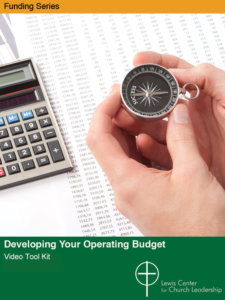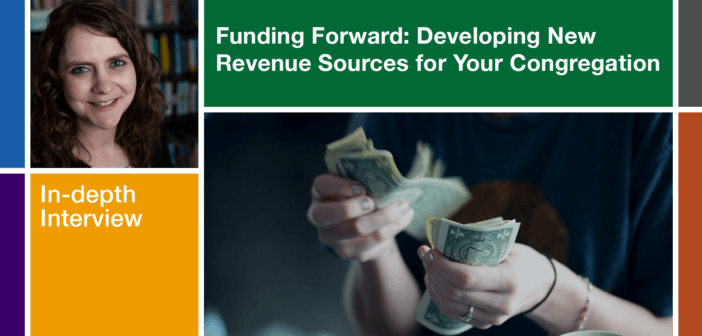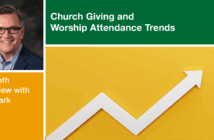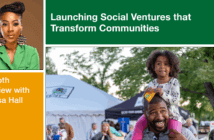Grace Pomroy from Luther Seminary shares research findings on how congregations are developing new and creative funding sources. In this in-depth interview with Ann Michel of the Lewis Center staff, she explains how congregations can lessen their dependence on Sunday morning offerings in ways that can bolster the bottom line while also building connections with neighbors and advancing the church’s mission.
Listen to this interview, watch the interview video on YouTube, or continue reading.
Ann Michel: Your Funding Forward research initiative identified about 200 congregations in the US and Canada who were experimenting with more sustainable financial models and surveyed what they were doing with an eye toward identifying what other churches can learn from their experiences. Can you name some of the alternate revenue streams that some of these congregations have developed, and then which are most common and significant?
Grace Pomroy: I think about this as kind of a collage. There were so many different ideas that came to the table. Oftentimes, when I talk to congregations, they want me to give them just one. But there is a whole array of choices, so you can focus on what seems best for your congregation and where God is leading you. Property is a big component for many congregations. Renting church property was highest on the list for the congregations that we studied. The sale of church property was also on that list as well. But there were other things like starting a business or a social enterprise, securing grants, repurposing endowment funds, or maybe joining an impact investment. There are a variety of different ways that congregations engaged in this work, which was really exciting to see.
Ann Michel: Some of these possibilities may be less familiar than others. For example, can you describe a social enterprise or an impact investment?
Grace Pomroy: A social enterprise is a business for good. It can be in a nonprofit format or a for-profit format, oftentimes outside the congregation. They can be as small as selling products or services in your congregation or as large as a business that’s separate from a congregation. One congregation we studied started a farm that sells bread and produce and gives some away, as well. I know of a campus ministry that started a pay-as-you-go deli on their campus during the pandemic because students needed that resource. Social enterprises come in a variety of forms and can be as small as a church bake sale. That’s a baby form of a social enterprise in that it has a good at the end of it, but it’s not necessarily a defined business structure. Usually, social enterprises will have their own defined business structure around them, whether for profit or nonprofit.
An impact investment is a way of investing in a specific ministry or project that isn’t a donation, rather it’s a social-impact-oriented investment. You’re putting money or principal in with the goal of getting a return while also doing good. So, for instance, I know of a campus ministry in Madison, Wisconsin, that was trying to build student apartments. They needed a loan to do that work, but they didn’t want to pay back as much interest. So, they asked their regional church body to make an impact investment that they could repay on different terms.
Ann Michel: You also mentioned grants. Often, congregations will get a grant from their denomination or other church-related entities. But you found that there were lots of other kinds of grants that can be accessed by congregations.
Grace Pomroy: Congregations often assume that because they are religious entities the only grants available to them are from faith-based foundations, regional church bodies, and denominations. But we found that other grant-making entities really value the church. For instance, if a church is developing affordable housing or starting a business that meets a community need, there can be granting bodies interested in those same needs. Sometimes to be eligible for these grants, a church may need to separate out that initiative into its own business entity. But I found it is more and more the case that this separation isn’t necessary, as long as the church can make a business case for why what they are doing matters to the individual granting organization.
Ann Michel: That’s really encouraging. Because I think a lot of church leaders assume that unless you create a separate 501(c)3 there are no available sources of grant funding. In addition to learning about different types of new revenue sources, you also learned a great deal about what makes these different approaches successful. What key practices and perspectives are important when congregations move toward a funding forward approach?
Grace Pomroy: Let’s be honest. A lot of congregations come to this conversation because they are running low on funds. I understand that. But we found that the congregations who were successful in this area didn’t just come to this for financial reasons. They used their financial circumstances as a catalyst to begin a larger conversation about what God might be calling them to do. Finances were not the sole motivation. Usually a biblical, theological, or missional motivation developed, as well.
We conducted in-depth interviews with 12 congregations in our research pool. And we found a couple of things that really sparked their success, both financially and in terms of missional impact.
- The first component was having a clear sense of what God was calling them to do and to be. What was God’s mission for their congregation? How were they invited to join God’s mission in their community?
- The second component was community need. What were the needs in their community? What were the hopes in their community? And what assets made their community unique?
- The third component that really motivated them to spring forward was having an underutilized asset. For many congregations, property was an underutilized asset. However, for others, it was something a little different. In one congregation, the staff had some untapped gifts and skills. For example, a staff member who was a baker, a staff member who was a farmer. That was something they could use. Other congregations had people who were really handy with tools. They knew they could do something with their building because they had a whole group of people who could make the building rentable. So, it’s not just property, although property could certainly be a piece of that puzzle.
When these three components come together, it really allows a congregation to make a broader impact in their community and to deepen their faith through this process. It was not just a financial journey.
Ann Michel: In addition to the financial advantages, you also found there were other advantages to these funding initiatives.
Grace Pomroy: Absolutely. This was the most eye-opening and fun part of the study for me. Every respondent who talked about a new income source on our survey was asked if they had any evidence of it allowing them to create meaningful relationships with people outside of the congregation — people whom they might not otherwise meet. Honestly, I had no idea what type of data we would get in response. But it became one of the most prominent pieces of survey data.
With all the different income sources, in almost every case but one, over 50 percent of the congregations using that income source said they were creating new relationships. And this was not just a one-off or a two-off situation. In most cases, this was opening a whole new door to people in their community that they would not meet otherwise.
One of the congregations has a farmers market stand where they sell soup. This has fostered some amazing relationships because the same people come back to the farmers market every week. They’ve also forged relationships with the farmers who helped them start this soup stand. They are getting to know about their customers’ lives and create relationships with them. And their goal is that people will not just buy soup for themselves, but also give it away to someone else. So, the relationships just keep rippling out from there. Formerly, this church felt like they were a black box in their neighborhood, that no one knew who they were. Now, the community sees them as an essential part of the fabric of that neighborhood. In short, they just had to look outside themselves and think about making connections.
The evangelism opportunities, the outreach opportunities, the relational things that can come about as a result of this are really significant. Often, at the beginning of this journey a congregation will ask, “Will this guarantee more butts in seats and more money through the offering plate?” They love the idea of creating relationships, but they see it transactionally. Will it result in more people coming to their congregation? To be clear, what we found is that the folks churches are meeting through these other income sources — whether they were renting out space in their building, participating in a social enterprise, or were a granter or a grantee in a program — were generally not joining the congregation. However, as word gets out in the community about what this church is doing, it attracts people who may not have gone to church otherwise, people who say, “Wow, I want to be a part of a church where that is seen as part of the ministry.” So, that’s how some of those relationships are blossoming and leading to evangelism moments in their community. But it’s not usually a one-for-one transaction.
Ann Michel: You also found there was a spiritual dimension to this work. Where do you see God in this?
Grace Pomroy: I see God in so many places in this work. And it’s the congregations we surveyed that taught me where God is in this work. We asked them, where do you see God in this process? Of the 101 people who participated in this survey, we had over 90 viable responses to this question. Last Christmas, I sat down to read through this data, and I wept at the stories they shared. They weren’t just saying, “God is everywhere. We see God in all places.” For the most part, it was a deep experience of God showing up for them in big miracles and small miracles. But also, they knew the peace and the resilience they were experiencing was the work of the Holy Spirit. I was amazed. And honestly, it has transformed my faith journey to see the ways faith and finances are coming together through the Funding Forward process.
Ann Michel: I know this wasn’t addressed in your research, but do you have a sense of how significant some of these trends are churchwide? The churches you studied were admittedly trailblazers. They attract a lot of attention from those of us who follow developments in stewardship and finance. But the Lake Institute’s Study of Congregations’ Economic Practices, which came out about four years ago, found that 40 percent of congregations didn’t have any source of revenue beyond contributions. And in aggregate, almost 90 percent of revenue coming into churches is coming from donations or more standard fundraising practices. Income from rentals and other property was only about six percent. So, do you think this trend toward alternate funding sources is accelerating?
Grace Pomroy: I would definitely say it’s accelerating. That Lake Institute Study, which was done prior to the pandemic, also revealed how much revenue was coming through the offering plate, mostly through physical transactions on Sunday morning. We know online giving has exploded because of the pandemic. Also, since the pandemic, as attendance has trended downward, many congregations have experienced a decline in revenue. In those congregations where revenue is not declining, it’s often because they have some older donors who sadly may soon be aging out of the congregation. When they pass away, it could be a real wake-up call. So, I encourage congregations to get into the conversation sooner rather than later. There’s nothing wrong with adding an additional income source that can be a buffer in the future. But will it be more necessary? Absolutely. As many congregations grow smaller, they will need to think about managing money differently. Instead of a “death by a thousand cuts” where they trim programs back bit by bit, how can they be more creative in funding some of these programs? Starting earlier gives you a little bit of a runway to make this happen.
Ann Michel: Half of the congregations in your research were urban and another quarter were suburban. Yet, I think it’s true in your denomination, as it is in mine, that the vast majority of our congregations are small rural congregations. Could you share a story from a smaller church in your study, a rural church?
Grace Pomroy: We did have fewer responses from small and rural congregations. So, we decided to overrepresent them in our interview work. One of the congregations we interviewed was in Gulf Shores, Alabama. They received a new pastor during the pandemic, and six months into her ministry she realized the congregation could only sustain a pastor’s salary for another two years. She actually had a finance background, and she said, “We need to make a change here. We need to make a big change. And it can’t just be a small thing. We’re not going to be around if we don’t make a shift.” So, they decided to look at all the different assets that had been entrusted to them. And, at the same time, they had conversations with people in the community to see what needs were present.
They discovered two needs in the community. One was childcare. And the other was affordable rentable office space. This particular congregation realized that childcare wouldn’t help them fill their finance gap. Another church we interviewed started a daycare and it’s been financially viable for them. It just wasn’t viable for this church. But they found the idea of creating affordable office space was viable and they shifted most of their building into rental space, renting out the staff spaces in their church office, most of their education wing, their church library, and parts of their fellowship hall. Amazingly, they were able to get seven different spaces rented within a year, in large part because a gentleman in the community was very handy and he was able to quickly bring those spaces up to date.
It’s been so exciting to learn how this has changed the perception of that church in the community — that it is a place where people can work and a place where they can worship. An artist who’s renting one of their spaces asked to put art up on the walls. The church musician shared how enlivening the conversation is around the coffee station now the renters are there. It really has allowed the church to come alive.
Rural congregations can definitely use their building space in different ways, even though their options might be different than those in urban or suburban contexts. For instance, I’ve seen many rural congregations open their space to medical professionals, which means people seeking health care won’t have to drive as far. There are different types of opportunities, but it is very different from an urban and suburban environment.
There is another small, rural congregation in New Hampshire that decided to move to a part-time ministry model, which is a viable option for them. They are still trying to figure out what it means to have a 50 percent pastor. What exactly does this look like? Who will take on the other responsibilities? What might need to be left behind? It was really exciting to see this congregation in the midst of this conversation, really focusing more on their lay leadership and what folks in the congregation are able to do.
Ann Michel: For congregations moving toward more creative funding sources, how can they still stay focused on helping their congregants learn to give generously?
Grace Pomroy: I’m so glad you asked! Because inspiring generosity is a passion of mine, as well. If you go down the path of pursuing different income sources, it’s really important to be incredibly transparent with the congregation. People have legitimate questions. And people will tend to overestimate the incoming coming from new sources. For example, I know a downtown congregation that rents its parking lot during the week to commuters. And members of the church just assumed this was yielding exceptional amounts of income that could fund the entire church.
Every church budget is different. But if you have a way to direct new funding sources toward a specific purpose, I encourage you to do so. For the congregation renting its parking lot, I think that revenue should go toward needed renovations of the church property. Don’t put your rental income towards the programs that people are most excited about. If you’ve got a great youth ministry, for example, you’ve already got people who will want to fund that.
I think the offering is still so important. But having some other sources of revenue frees us to think about the offering in really generative ways. I was once part of a congregation that had many college students, people who were just starting out in their careers, and entrepreneurs. When the offering was just one note of “give money,” it really didn’t resonate with them. So, we had different offering stations. People could give money. They could offer prayers. We had places where people could volunteer. And we had an area where people could interact with the sermon and put it into practice.
The offering is an act of worship. And financial giving is a piece of that. But there are other things God has entrusted to our care that we are called to give. Putting other income sources in place gives us a little bit more freedom, so that the offering isn’t just begging for money, but helping people understand generosity as a spiritual practice and grow into that practice, not out of scarcity or necessity, not just as a way to pay the church’s bills, but as a true form of congregational generosity that might benefit others, as well.
Ann Michel: For churches that want to start pursuing some of these more creative and sustainable funding sources, how would you recommend that they get started?
Grace Pomroy: I recommend that you start in two ways. First, take the time to inventory the assets that God has entrusted to your congregation’s care. People often come to this conversation feeling that resources are really tight and things are really scarce. They’re assuming they have nothing. So, it’s important to take a step back and appreciate what you do have.
I encourage people to think about a couple of categories. What are your financial or physical assets? What are some of the skills in your community? What about time assets? Who in your community and congregation might have some time that they can share? Also, what are your network assets? This is probably one of the most underutilized assets. Who is in your congregation’s network? Who might you partner with? Because no congregation does this work alone. Partnerships are a key piece of the puzzle.
Then, think about what’s unique about your particular context. What’s a little different about us? For instance, a congregation who was a part of our survey in Detroit has a lot of young men who were previously incarcerated and not able to get traditional jobs. But they had a lot of ideas for how they might be entrepreneurial and serve their community. That was a unique asset. But it doesn’t fall on paper in a church’s budget.
It’s also important not to overlook the work of discernment. How are you called to participate in what God is up to in your community? Take time to really listen to community members. Ask them what they need. Listen to their hopes and their dreams for the community. Ask who else you should talk to. Also, take time to cultivate God language in your community. In mainline denominations like the ELCA, we’re not used to talking about what God is up to in our community. And it takes time to learn that language. But this is often more about listening and then beginning to put our arms around what God is calling us to do.
Ann Michel: I think many church leaders come into the ministry without the skill set needed to think and act more entrepreneurially. What are some things that leaders can do to prepare themselves to be a bit more entrepreneurial and manage some of these new undertakings?
Grace Pomroy: The good news for leaders is that you already have the skill sets in place to do this work. The best things you can bring is your vision for what God is up to in the community and coach and encourage those in your community who want to participate. No matter how small your congregation is, you likely have people who have never volunteered because they never felt fit to be a greeter or a Sunday school teacher or a reader on Sunday morning. But they would love to pick up their hammer and tools and be a handyman. There might also be entrepreneurs in your congregation who say, “Hey, I get all the business stuff. I can do that. But I need to know how this relates to ministry.”
Your job is to be that translator. And this can be really challenging for leaders because we’re used to being the ones who lead the way and others follow us. And in this case, it’s going to be a more collaborative work where we each bring our gifts.
 Related Resources
Related Resources
- Developing Your Operating Budget, a Lewis Center video tool kit resource
- Adding New Income Lines to Your Church Budget by Grace Pomroy
- Leveraging Church Property Can Sustain Your Mission by Lovett H. Weems Jr. and Ann A. Michel
- When Churches Engage the World of Business by Audrey Warren
Photo by Alexander Grey on Unsplash






